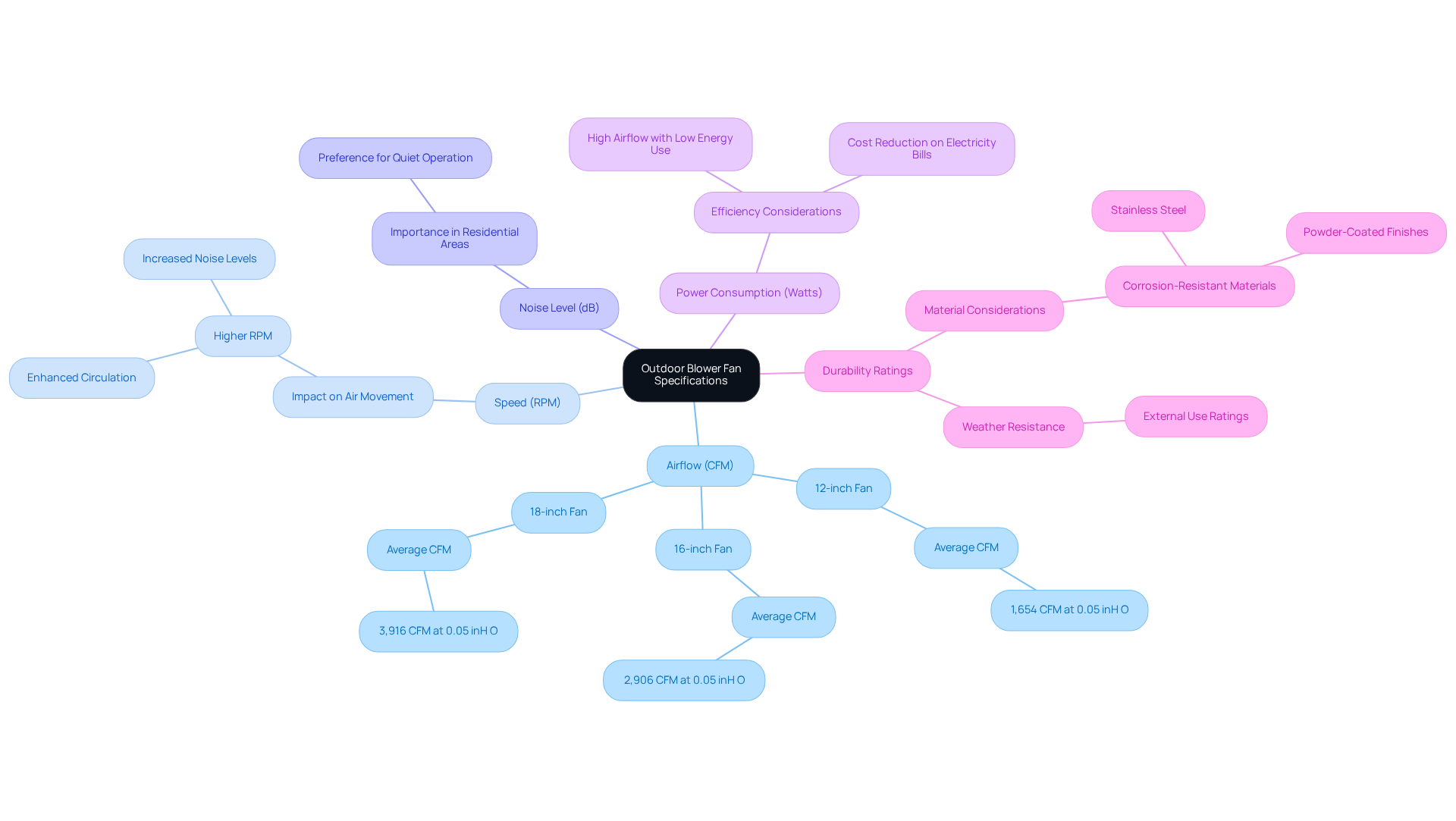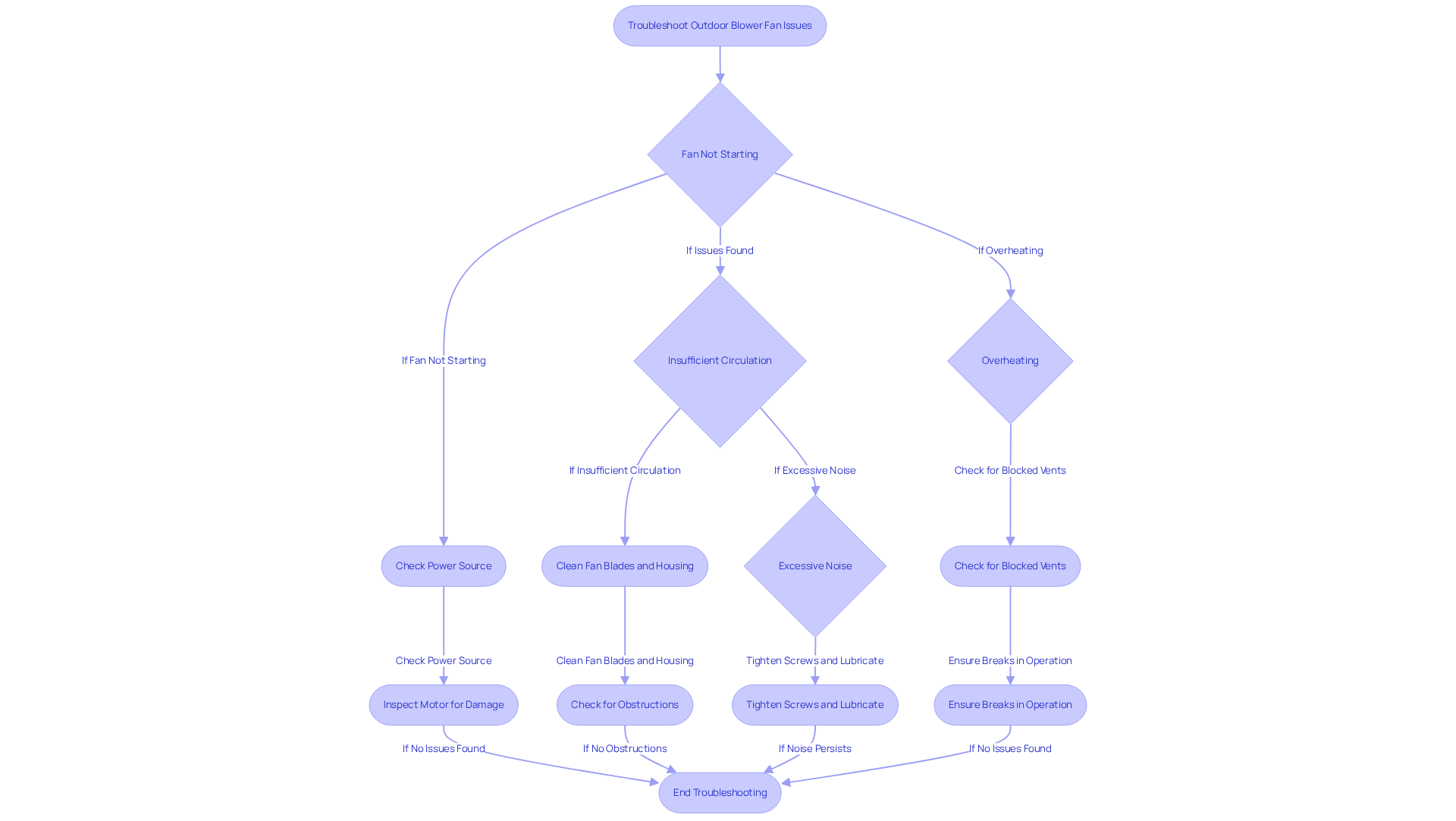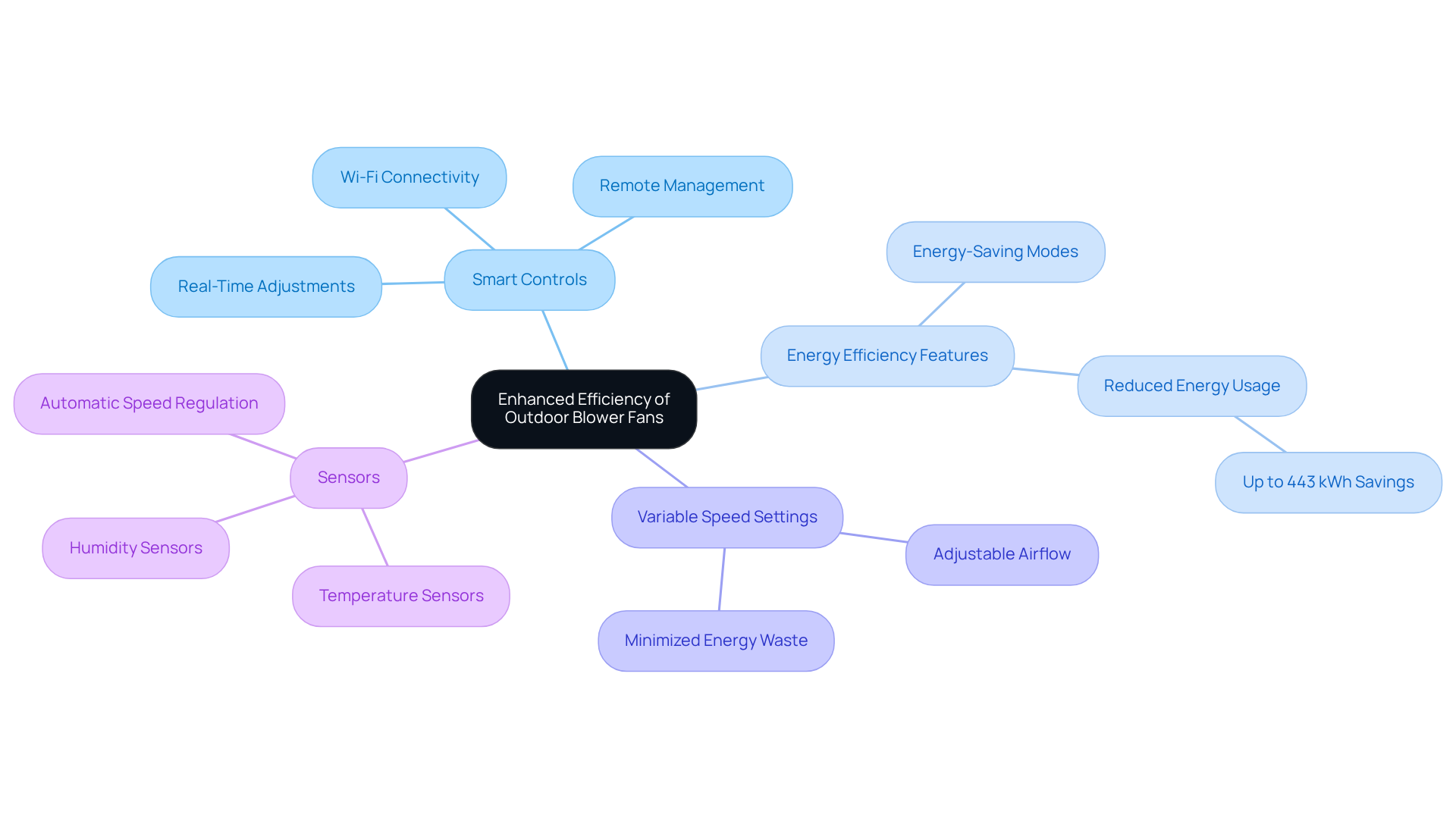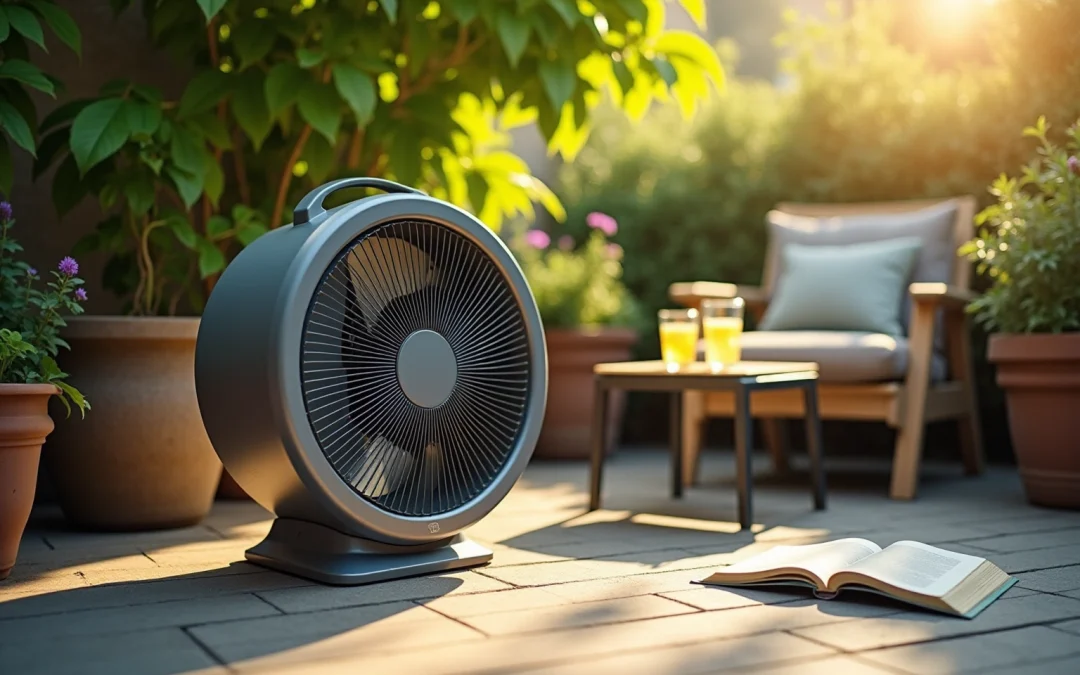Overview
The article provides a comprehensive overview of the specifications, troubleshooting, and technological advancements associated with outdoor blower fans. It underscores the necessity of grasping key metrics such as airflow (CFM), speed (RPM), and noise levels to achieve optimal performance. Furthermore, it brings to light modern features, including smart controls and energy efficiency technologies, which not only enhance usability but also contribute to reducing energy costs.
Introduction
Understanding the mechanics behind outdoor blower fans unveils a domain where air movement intersects with engineering excellence. These devices are pivotal in enhancing comfort and ventilation within open spaces. However, selecting the appropriate model requires navigating a complex array of specifications and performance metrics.
What occurs when the fan fails to start, or when it struggles to circulate air effectively? This article explores the essential features of outdoor blower fans, outlines common troubleshooting techniques, and examines the integration of modern technologies that promise to elevate their efficiency and usability.
Explore the Fundamentals of Outdoor Blower Fans
External air movement devices are engineered to circulate air effectively in open environments, delivering essential cooling and ventilation. Gagner-Toomey Associates, recognized as the world’s largest producer of both standard and custom air-movers, offers a diverse range of that are optimized for performance, efficiency, and minimal noise. These fans predominantly operate through centrifugal force, generated by a motor that spins the fan blades. Key components include:
- Motor: The core of the fan, this component powers its operation and dictates both speed and airflow capacity. Motors are typically rated in horsepower (HP), with higher ratings indicating greater air movement potential. Gagner-Toomey Associates provides options across a spectrum of sizes, including DC input Tube Axial fans from 15 to 280mm and Centrifugal Blowers from 15 to 225mm.
- Fan Blades: Crafted for optimal airflow, these blades are designed to minimize noise while maximizing efficiency. The design of the blades can significantly influence the fan’s performance, with configurations ranging from backward-inclined to forward-curved.
- Housing: This component protects internal parts and is often constructed from weather-resistant materials to ensure durability in outdoor conditions. Many models also provide IP protection upon request.
Understanding these elements is crucial for selecting the appropriate outdoor blower fan for specific applications, such as cooling outdoor spaces, drying wet areas, or enhancing air circulation. For instance, outdoor blower fans are particularly efficient in external ventilation scenarios due to their ability to generate high airflow rates while maintaining effectiveness. In practical applications, units with a higher cubic feet per minute (CFM) rating are preferred for larger areas, as they can move more air in a shorter timeframe, making them ideal for commercial landscaping or large events.
Expert insights underscore the significance of choosing the right motor specifications and fan blade designs to achieve optimal performance outcomes. An outdoor blower fan that is equipped with a high CFM and appropriate blade design can effectively transport heavier items, illustrating the practical applications of centrifugal force in exterior fan systems. Furthermore, Gagner-Toomey Associates provides custom designs tailored to meet specific customer requirements, ensuring that engineers can identify the perfect solution for their projects.
Evaluate Key Specifications and Performance Metrics
When selecting an outdoor blower fan, it is crucial to carefully evaluate several key specifications to ensure optimal performance and efficiency.
Airflow (CFM) is a critical metric that measures the volume of air the fan can move. Higher CFM ratings indicate superior cooling performance. For instance, a 12-inch fan typically averages around 1,654 CFM at 0.05 inH O static pressure, while a 16-inch fan can reach approximately 2,906 CFM under similar conditions. This distinction is vital for matching the fan to specific cooling needs.
Speed (RPM) refers to the revolutions per minute of the fan blades, which directly affects air movement. While higher RPM can enhance circulation, it may also result in —a critical consideration for residential applications where comfort is paramount.
Noise Level (dB) is particularly important in residential areas. Fans that operate quietly are generally preferred, especially in open environments where sound can disrupt daily activities. Selecting a fan with an acceptable noise level can significantly enhance user experience.
Power Consumption (Watts) is another essential factor. Efficiency is key; opting for devices that deliver high airflow while consuming less energy can substantially reduce electricity expenses. Energy-efficient models enable users to raise their thermostat settings by several degrees without compromising comfort, making them a smart choice.
Durability Ratings must also be considered. Ensure the fan is rated for external use and constructed from materials capable of withstanding severe weather conditions. Fans made from corrosion-resistant materials, such as stainless steel or powder-coated finishes, are ideal for longevity and reliability.
Furthermore, routine upkeep can prolong the lifespan of exterior blower units, ensuring they remain effective over time. It is crucial to consider the impact of environmental conditions on fan performance, as these factors can significantly influence air movement and efficiency. Additionally, selecting an outdoor blower fan based on adjusted static pressure and air movement requirements is essential for achieving optimal performance in external applications. Understanding these specifications is vital for making an informed choice.

Troubleshoot Common Issues and Enhance Performance
Common issues with outdoor blower fans include:
- Fan Not Starting: Begin by checking the power source; ensure the circuit breaker is not tripped. Inspect the motor for any signs of damage, as a faulty capacitor can often prevent the fan from starting.
- Insufficient Circulation: Clean the fan blades and housing to remove dust and debris, which can limit circulation. Additionally, ensure there are no obstructions in the ventilation path, as even minor blockages can significantly reduce efficiency.
- Excessive Noise: Unusual sounds may indicate loose components or worn bearings. Tighten screws and lubricate moving parts as needed to minimize friction and , which can lead to motor failure.
- Overheating: Ensure the fan is not running continuously without breaks, as this can lead to overheating. Check for blocked vents that may restrict airflow and cause the fan to work harder than necessary.
Regular maintenance, including cleaning and lubrication, is essential for optimal performance. Statistics indicate that proper care can prolong the life of HVAC equipment by up to 50%. It is recommended to check the fan every 3 to 6 months to prevent unexpected failures and costly repairs. Case studies emphasize the effectiveness of routine checks in identifying potential issues early, ensuring devices operate efficiently and reliably. Neglecting fan maintenance can lead to increased energy consumption and operational downtime, underscoring the importance of a structured maintenance schedule.

Integrate Modern Technologies for Enhanced Efficiency
Modern outdoor blower fans are increasingly designed with advanced technologies that significantly enhance their efficiency and usability.
- Smart Controls: Many contemporary fans now feature Wi-Fi connectivity, allowing users to manage settings remotely through smartphone applications. This convenience facilitates real-time adjustments based on user preferences and environmental conditions, ultimately improving user experience.
- : It is essential to consider units designed with energy-saving modes that intelligently adjust power consumption. Such features can lead to substantial decreases in energy usage, with research indicating that intelligent ceiling devices can save up to 443 kWh over an average usage duration, as demonstrated in the ‘Energy Consumption Analysis of Smart Ceiling Devices’ case study.
- Variable Speed Settings: Fans equipped with adjustable speed settings optimize airflow according to specific needs, thereby minimizing energy waste. This adaptability is crucial for maintaining comfort while keeping energy costs low, ensuring users receive maximum benefit from their investment.
- Sensors: Advanced models often include integrated temperature and humidity sensors that automatically regulate fan speed, thus ensuring optimal comfort without unnecessary energy expenditure. For instance, the incorporation of IoT technology in ceiling devices has shown a 50% decrease in energy loss compared to conventional models.
By leveraging these modern technologies, users can significantly enhance the functionality of their outdoor blower fan while effectively reducing energy costs. This makes them a smart choice for both residential and commercial applications.

Conclusion
Mastering the intricacies of outdoor blower fans is crucial for optimizing air circulation and enhancing comfort in various outdoor settings. Understanding the fundamental components, specifications, and modern technological integrations empowers users to make informed decisions that elevate their experience and efficiency.
Key considerations include:
- Selecting the right motor and fan blade design for optimal airflow.
- Evaluating performance metrics such as CFM, RPM, and noise levels.
- Recognizing the importance of regular maintenance to prevent common issues.
Additionally, the integration of smart technologies and energy-efficient features reflects the evolving landscape of outdoor blower fans, ensuring they meet contemporary demands for performance and sustainability.
As outdoor environments become increasingly vital for both residential and commercial applications, investing in the right outdoor blower fan is paramount. Embracing modern technology not only enhances functionality but also promotes energy savings, making it a prudent choice for the future. Whether for cooling, ventilation, or improved air quality, the right outdoor blower fan has the potential to transform open spaces into comfortable and enjoyable areas.
Frequently Asked Questions
What are outdoor blower fans designed for?
Outdoor blower fans are engineered to circulate air effectively in open environments, providing essential cooling and ventilation.
Who is Gagner-Toomey Associates?
Gagner-Toomey Associates is recognized as the world’s largest producer of both standard and custom air-movers, offering a diverse range of outdoor blower fans optimized for performance, efficiency, and minimal noise.
How do outdoor blower fans operate?
Outdoor blower fans predominantly operate through centrifugal force, which is generated by a motor that spins the fan blades.
What are the key components of outdoor blower fans?
The key components include the motor, fan blades, and housing. The motor powers the fan, the blades are designed for optimal airflow and noise reduction, and the housing protects the internal parts.
What role does the motor play in an outdoor blower fan?
The motor is the core component that powers the fan’s operation, dictating both speed and airflow capacity. Motors are rated in horsepower (HP), with higher ratings indicating greater air movement potential.
What types of fan blades are used in outdoor blower fans?
Fan blades are crafted for optimal airflow and designed to minimize noise. They can have various configurations, including backward-inclined and forward-curved designs.
How does the housing of an outdoor blower fan contribute to its functionality?
The housing protects the internal components and is often made from weather-resistant materials to ensure durability in outdoor conditions. Many models also offer IP protection upon request.
What are some practical applications of outdoor blower fans?
Outdoor blower fans are efficient for cooling outdoor spaces, drying wet areas, and enhancing air circulation. They are particularly effective in external ventilation scenarios.
What should be considered when selecting an outdoor blower fan?
It is crucial to consider motor specifications, fan blade designs, and the fan’s cubic feet per minute (CFM) rating to achieve optimal performance for specific applications.
Can Gagner-Toomey Associates provide custom outdoor blower fan designs?
Yes, Gagner-Toomey Associates offers custom designs tailored to meet specific customer requirements, helping engineers identify the perfect solution for their projects.

